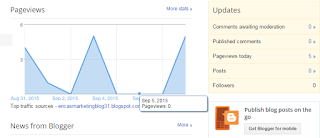The weebly site I created, that was mentioned in the previous blog post, has now been published. The next step is to link Google Analytics to my website. Once I link Weebly and Google Analytics, I will be able to track the submission forms that come into my site. The process for linking the two is not complicated but there are a few steps involved.
To begin, you need to log-in to your Google Analytics account. Then you need to create a new account. To create a new account you go to admin and then under the account tab you click on the pull down bar. Once the list pops up you click create new account. You are then prompted to fill in some boxes. The first one you fill in is your account name. Your account name should be a phrase that helps you identify what account you're looking at. Then you set up a website name. The website name name should be specific enough that you can differentiate it from all your other accounts. Then you copy and paste your URL form your website into the website URL space. After you do these three things you can click get tracking code at the bottom of the page. Once you get the tracking code, you should copy it so you can paste it into Weebly.
Now you need to go to Weebly and click on settings. Under the settings section you then click on SEO. Once you have done this, you then paste your tracking code into the footer code box and hit save. For the code to be applied you have to publish your site again.
The next stop for my project was to track conversions. To do this, you have to go back to Google Analytics and set up a goal. Again, you go to Admin and then under view you click goals. Once you click goals there is a red box you can click on at the top of the screen that says "create new goal". You have to first type in your goal description. The description should be something that represents what you are tracking, for this case I used "Contact Information Obtained". Then you select the type of goal you want, which for me was destination. I used destination because I wanted to know when people reached a certain page, or made it to the correct destination. The next step is adding the actual goal destination. For this part you just take the link from your site, which for mine was http://ericakotsovos.weebly.com/thank-you.html, and paste it into the destination box. However, since I already connected Weebly and Google Analytics all I needed to paste was the part after the .com. So I copied /thank-you.html into my destination box.
Once you have done these steps you can verify your goal to make sure it works. If everything looks good, then you can save your goal and Google will start tracking it. After all this, you are finally done!
 |
| Google Analytics page showing conversion tracking |



